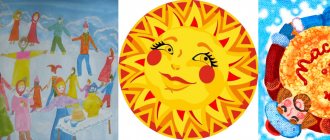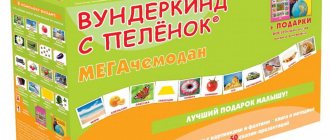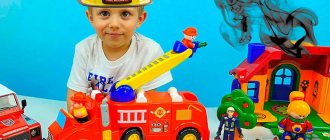The main task of games during this period is the formation of emotional contact and children’s trust in the teacher. The child should see in the teacher a kind person, always ready to help (like a mother) and an interesting partner in the game. Emotional communication arises on the basis of joint actions accompanied by a smile, affectionate intonation and a manifestation of care for each child. The first games should be frontal, so that no child feels deprived of attention. The initiator of all games is an adult. Games are selected taking into account the children's playing abilities, location, etc.
Six golden rules
After the improved Tic-Tac-Toe, Alena began to come up with the following games, and in the process she identified seven important rules for herself that will become the key to an interesting and useful game:
- The game is for kids, not adults. To keep children interested, don't make the game too hard or too easy.
- For children it is entertainment, for the teacher it is a tool. The game is not just for fun. And if this is entertainment for children, then the teacher must formulate the goal that he wants to achieve with this activity, for example, to consolidate educational material or develop the logical thinking of children.
- "Squares" is a universal playing field. For an introduction to floor games, the universal playing field “Squares” is perfect: a rectangle made up of 24 squares. The recommended size is 1.4 by 2.8 meters to make it easier for children to move around. You can create the playing field yourself, for example, draw squares with electrical tape on the floor, or you can use ready-made material, for example, banner cloth.
- Game is movement. Think about what the child should do: remove pictures, spin a hoop, jump with a ball. Children love movement, and standing still will be boring for them.
- Rules are the basis of order. Think and clearly explain to children what can be done during the game and what cannot be done. This will make it easier to control the process and achieve didactic goals.
- Everything is good in moderation. To prevent children from getting bored with games, it is optimal to conduct them no more than two or three times a week. The exception is play activity during morning exercises: it is part of an exercise cycle and takes only a few minutes.
Alena came up with a whole series of outdoor games, which were included in her collection “Outdoor Games and Activities for Children,” and shared with us five activities that can easily be done with kids.
Didactic games
The games below will not only encourage the timid and cheer up the crying one, but will also calm the overly naughty child, redirect attention and help relax the angry, aggressive child.
Playing with a dog
Material. Toy dog.
Progress of the game. The teacher holds the dog in his hands and says:
Bow-wow! Who's there? This is a dog visiting us. I put the dog on the floor. Give Petya a paw, little dog! Then he approaches the child, whose name is named, with the dog and offers to take it by the paw and feed it. They bring a bowl of imaginary food, the dog “eats soup,” “barks,” and says “thank you!” to the child.
When repeating the game, the teacher calls the name of another child.
Collecting "treasures"
Material. Basket.
Progress of the game. During a walk, the teacher collects “treasures” (pebbles, pods, twigs, leaves, shells) with the child and puts them in a basket. Finds out which “treasures” arouse the greatest interest in the baby (this will suggest further ways of communication). Then he names some “treasure” and asks to take it out of the basket.
Making a collage
Material. Scraps of colored paper, greeting cards, string, pieces of foam, yarn, etc.
Progress of the game. The teacher spreads a large sheet of thick paper or cardboard on the table. Using a brush, coat a piece of foam plastic (postcard, etc.) with glue on one side and hand it to the child to stick it on the paper. Allows the child to choose the items he would like to stick on. After carefully observing the actions of an adult, the child will be able to apply the glue himself. The completed collage can be hung in a prominent place for everyone to admire.
(The game helps develop creative skills.)
Caught a fish
Material. Cardboard box, metal bottle caps (“fish”), magnet, stick and rope (for a fishing rod).
Progress of the game. Several metal bottle caps, preferably of different colors, are placed in a cardboard box. A stick is tied to one end of the rope (or ribbon), and a magnet bar is tied to the other. The teacher shows the child how to fish “fish” out of the box by attracting metal plugs with a magnet. If the corks are different colors, then the baby can be asked to pull out, for example, a red fish.
After all the plugs have been removed, the adult counts them (“That’s how many fish we caught!”), and the game starts over.
(The game helps develop coordination of movements.)
Let's ride a horse
Material. Rocking horse (if there is no horse, you can sit the child on your lap).
Progress of the game. The teacher puts the child on a rocking horse and says: “Masha is riding a horse, (says in a quiet voice) no-no.” The child repeats quietly: “No-no.” Adult: “To make the horse run faster, tell it loudly: “No-no, run, little horse!” (Swings the child more strongly.) The child repeats the phrase together with the teacher, then independently. The adult ensures that the child pronounces the sound “n” drawn out, and the entire sound combination loudly and clearly.
(The game develops speech activity).
Blow into or onto something
Progress of the game. The teacher blows on a small balloon through a straw, causing it to move around the room. Blows on all fingers, then on each one separately. Blows a leaf from the child's palm. Blows on a flower or blade of grass. The child repeats the actions of the adult.
Blow on the balloon, blow on the pinwheel, blow on the horn
Material. Balloon, pinwheel, horn.
Progress of the game. A balloon is suspended at the level of the child’s face, and a pinwheel and a horn are placed on the table in front of him. The teacher shows how to blow on a balloon so that it flies high, and invites the child to repeat the action. Then the adult blows on the turntable to make it spin, blows the horn, and the child repeats.
(The game promotes the development of the speech apparatus).
Book - guess what?
Material. Notebook with spiral wire.
Progress of the game. Paste pictures of objects known to the child across the page (on the right side) in the notebook. Each page without pictures is cut into several horizontal strips, starting from the left edge. Looking at the book with the baby, the teacher gradually turns away strip after strip. The child tries to guess what is shown in the picture.
(The game develops imagination and logical thinking).
Fun with a magnifying glass
Material. Magnifying glass (preferably plastic).
Progress of the game. During a walk, the teacher gives the child a blade of grass. Shows how to look at it through a magnifying glass. Invites the child to look through a magnifying glass at fingers and nails - this usually fascinates the baby. While walking around the site, you can examine a flower or the bark of a tree, examine a piece of earth: are there any insects there, etc.
(The game develops observation skills).
Walking along the outlines of different figures
Material. Wide dense tape (braid).
Progress of the game. Using tape, circles, squares, triangles, etc. are depicted on the floor. The teacher shows the child how to walk along the tape (start with a circle). An adult takes the baby by the hand, walks with him and sings to any tune: “We are walking in a circle, tra-la-la, tra-la-la. We go in a circle, tra-la-la, tra-la-la." This is how all the figures pass. Then the teacher tries to walk along them with the child, walking backwards, sideways, on tiptoes, jumping over the figure, etc.
(The game contributes to the development of ideas about objects).
Together with the bear
Material. Toy bear.
Progress of the game. The teacher talks “as equals” with the bear and the child, for example: “Katya, do you like drinking from a cup?”, “Misha, I like it. Knocks fist on fist, claps his hands. Alternating such actions, the teacher creates a certain sequence of sounds, for example: knock-clap, knock-knock-clap, knock-clap-clap, etc.
Report on the topic “MODERN GAME IN KINDERGARTEN”
Khabibullina Z.A.
MADOU Kindergarten No. 15 “Rodnichok”, Birsk
MODERN GAME IN KINDERGARTEN
In the modern world, the game is losing its position. Childhood is losing the meaning of a unique age period where the true source of development is live communication and play. The modern child is less and less involved in relationships of cooperation, mutual assistance, and partnership. Reducing play in preschool age can have the most dire consequences for the personal development of the younger generation.
The game occupies a strong place in the system of physical, moral, labor and aesthetic education of preschool children. It activates the child, helps to increase his vitality, satisfies personal interests and social needs.
The culture of gaming in the modern world is losing its position. Childhood is losing the meaning of a unique age period where the true source of development is live communication and play. The modern child is less and less involved in relationships of cooperation, mutual assistance, and partnership. The toy market is saturated with all kinds of models, but, as observations show, most of them are focused on individual use. The transmission of traditions from older children to younger ones, from adults to children is lost. The modern system of education and training has not only separated children from the world of adults, but also separated them from each other. A TV or a computer is now a child’s best friend; they shape a very specific adult. It turns out that modern society focuses its members on individuality.
When organizing such games, it is important to take into account the peculiarities of modern social life. For example, a more typical image of a store is a supermarket. Instead of a regular hairdresser, a child often encounters a beauty salon with a wide range of services. Under the influence of wide familiarization with social reality and the media, new game themes appear in the child’s play repertoire: “Book supermarket”, “Travel agency”, etc.
The parental position also deserves special attention: to form an attitude towards play as a way of development. In society, the value of early intellectual achievements increases, but the importance of interpersonal and moral personality formation, which is so necessary for gaming activity, decreases.
Only role-playing play, including relationship building, can influence the child’s mental development. The child must gain experience in play activities in interaction with adults, peers, and strive to understand the social reality that surrounds him.
During the observations, it was discovered that among modern children, professional and socio-political stories are “suppressed” by television ones. This suggests that the real experience of modern preschoolers is limited, on the one hand, by everyday life, and on the other, by plots related to action films or virtual characters that came from the TV screen. The real social and professional life of adults becomes closed to children.
The lack of relevant experience and the resulting image of adulthood is an obstacle to the development of professional and social stories related to the lives of adults.
There are problems with the play of preschool children, and they are obvious:
1. The plots of the games of modern preschoolers reflect mainly the everyday side of life and television topics. Professional and social subjects are presented minimally.
2. For most modern preschoolers, play does not reach its developed form.
3. Many children find it difficult to establish contact in role-playing games, take on the role of a leader, and not deviate from the rules of the game.
4. The level of play development of modern preschoolers is significantly lower than that of their peers from the middle of the last century.
The current situation prompts us to raise the question of developing a more serious and responsible attitude towards the game of preschoolers - both among teachers and parents
“Games with rules - types, features of use in a group”
Traditionally, a game with rules appears in modern domestic pedagogy as a kind of antagonist of a plot game. Most practical teachers quite rightly believe that story-based play, or as it is often called, creative play, can take the form of a child’s free and independent activity. Another thing is playing with rules. This type of play is presented either as an ordered motor activity organized by an adult, during which children do not simply move randomly, but obey rules, the implementation of which is monitored by the teacher. Another popular form of games with rules in kindergarten is children playing with printed board games, such as dominoes, lotto and “goose”. In all of these games, the main attention of all participants, children and adults, is paid to the content of the game, its plot basis.
Games with rules represent a very extensive layer of activity for a preschool child. It is generally accepted that play with rules is of great importance for the physical, sensory and mental development of children. But, as a number of modern scientists note, the main developmental significance of a game with rules is associated with its specific characteristics. First of all, this is the development of independent normative regulation of behavior in children. If there is a rule (norm) that is mandatory for all participants, there is a need to monitor their implementation. In children, in their independent activities, conditions are created and the need arises for the implementation of such an important moral principle as justice.
A game with rules is characterized by competitive relationships between participants. The child has the opportunity to independently distinguish himself from other children, in accordance with simple and understandable criteria. For the development of a child, the fact of not only winning, but also losing is important. The experience of failure in a game contributes to the emergence in the child’s character of very important qualities (perseverance, the ability to achieve a given task, etc.), which will be useful to him in later life.
The whole life of a preschooler is connected with play. Mastering the things around him, relationships between people, understanding the meanings that social life carries, the work and responsibilities of adults - he gets acquainted with all this while playing, imagining himself in the role of mom, dad, and so on.
During the preschool period, the basic volitional qualities of the individual begin to form: perseverance and perseverance, determination, quick decision-making and bold implementation of them; self-control, that is, lack of vehemence when a conflict arises, independence, responsibility and discipline. Preschool age is a unique period in a child’s life, in which the foundations of personality are laid, the arbitrariness of mental processes is developed, creativity, activity and initiative develop. All these important qualities are formed in the process of carrying out the preschooler’s leading activity - in play. The most important role in the development of older preschoolers is played by those qualities and mental processes that are associated with the child’s ability to carry out complex, detailed play activities, primarily role-playing games with a plot, with the distribution of roles and rules. One of these qualities is will. Features of the development of will in preschool childhood are: the formation of goal setting, the emergence of struggle and subordination of motives, the emergence of internal control in behavior, the development of the ability to exert volition, speech planning of activities, encouraging adults and peers to carry out their own plans, arbitrariness in the sphere of movements, actions, and also cognitive processes and communication with adults.





